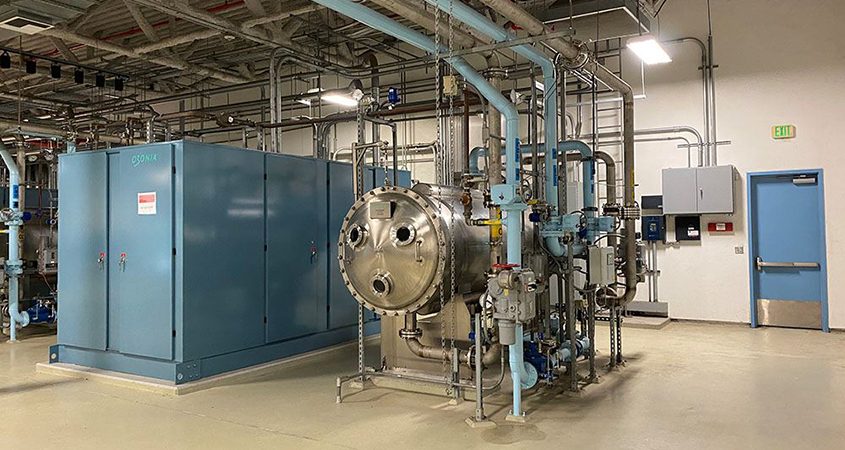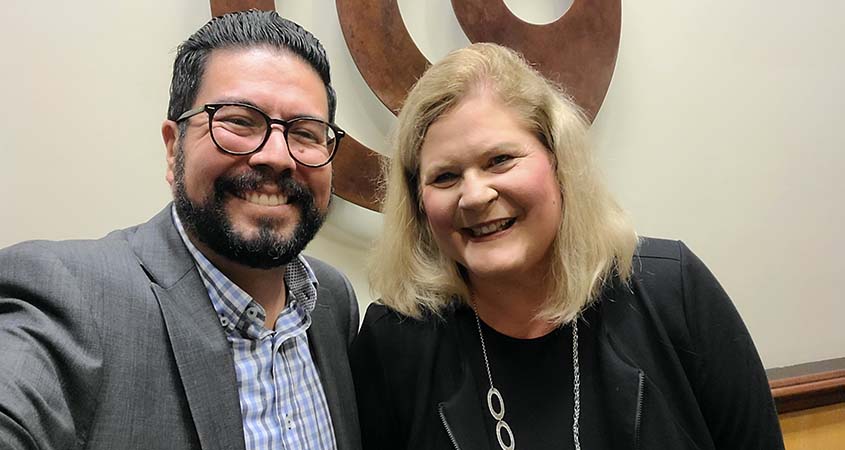Bluefield: Portland, Oregon, Tops U.S. Cities for Highest Average Monthly Water Bill
According to a new report from Bluefield Research, the combined water and sewer bill for a typical U.S. household has increased by 56% since 2012, or 4.2% annually.
According to a new report from Bluefield Research, the combined water and sewer bill for a typical U.S. household has increased by 56% since 2012, or 4.2% annually.
Ahead of next week’s controversial vote on the detachment of two North County water districts from the San Diego County Water Authority, several local leaders voiced their concern for how the proposed divorce could impact water rates.
A recent upgrade to a Helix Water District treatment plant saved money for its ratepayers while ensuring a continued supply of high quality drinking water.
After 20 years of service, the ozone disinfection system at the R.M. Levy Water Treatment Plant needed an upgrade. The projected cost of outsourcing the work needed came to $3.5 million. Instead, Helix staff at the plant proposed doing the work themselves – and they did – saving an estimated 70% after the work was completed for $1.1 million.
“With infrastructure projects, we always start with two questions,” said Helix Water District General Manager Brian Olney. “Do we replace it or can we rehabilitate it? And, is it better to outsource the work or do it in-house? These two questions saved our customers millions of dollars this year and are a good example of how we continuously look for ways to save our customers money.”

The Helix Water District uses ozone generators to reduce the use of chlorine as a primary disinfectant. Ozone inactivates a wide range of microorganisms, needs little contact time with the water, and it eliminates most of the odor and taste issues some people associate with tap water. Photo: Helix Water District
Water treatment is a multi-step process. First, organic material suspended in the water is removed. Water is then disinfected to remove or inactivate harmful microscopic organisms. Finally, the water is filtered.
Chlorine is the most widely used disinfectant at conventional water treatment plants. The Helix Water District uses ozone as its primary disinfectant, supplemented with chlorine. Ozone inactivates a wide range of microorganisms, needs little contact time with the water, and it eliminates most of the odor and taste issues some people associate with tap water. This mix maintains the quality of the water while it makes its way through the water distribution system.
The treatment plant uses an ozone generator, which produces ozone by applying high amounts of electricity to oxygen gas. The oxygen molecules (O2) split and regroup as ozone (O3). The ozone gas then bubbles up through the water to inactivate any microorganisms present.
Helix maintenance staff worked closely with the manufacturer of its original ozone system installed in 2002. The same manufacturer supplied new hardware and electrical components required for the upgrade. The ozone disinfection system includes the gas feed systems, generators, power supply units, and the instrumentation hardware and software controlling the system.
The project began with a proof-of-concept pilot project two years ago. Once the methods were tested, each of the three ozone generators was upgraded with the new technology, then tested and commissioned.
In addition to the 70% estimated cost savings from the upgrade project, the improved efficiencies of the ozone generators will produce long-term cost savings.
The ozone generators and their power supply units are now fully upgraded thanks to the efforts of the Helix team. The last phase of the project is the replacement of the computer control system, which is scheduled for 2024.
(Editor’s Note: The Helix Water District is one of the San Diego County Water Authority’s 24 member agencies that deliver water across the San Diego region.)
The final shutdown for scheduled maintenance of the San Diego County Water Authority’s First Aqueduct started today, February 27. The shutdown will run through March 8, allowing crews to reline portions of the historic aqueduct and perform regular maintenance work that ensures a safe and reliable water supply for the region.
The San Diego County Water Authority has secured $3 million in grant funds to install water-saving devices — water-efficient toilets and smart irrigation controllers — in underrepresented communities across the region, bolstering the agency’s long-running efforts to enhance water affordability.
The Water Authority will use the money to install 7,300 high-efficiency toilets and smart irrigation controllers covering about 4,000 locations, saving more than 6,000 acre-feet of water and helping enhance water efficiency and affordability for vulnerable customers. The funds are from the California Department of Water Resources’ Urban Community Drought Relief Grant program, designed to advance Governor Gavin Newsom’s strategy to adapt California’s water supply for a hotter and drier future.
“This is another big step toward our goal of ensuring that everyone in San Diego County has access to safe, reliable and affordable water,” said Water Authority Board Chair Mel Katz. “Helping customers improve water efficiency ultimately saves them money and protects our most precious natural resource.”
In 2022, the Water Authority secured $25 million to cover overdue residential water bills resulting from the economic impacts of COVID-19. The Water Authority also operates an industry-leading asset management program designed to avoid the extreme costs of emergency repairs on large-scale water lines. And, the agency is advocating in Washington, D.C., for federal funds to defray the cost of generational upgrades to local dams and reservoirs.
The Water Authority’s Water-Use-Efficiency Direct Installation Program is designed to save residents money on water costs. To be eligible for the direct-install program, residents in manufactured housing communities, multifamily and single-family homes must be a customer within the Water Authority service area. Details and how to participate: www.synergycompanies.com/utility-program/sdcwa-dip or call 888-272-8394.
The direct-install program conserves water by replacing inefficient toilets with high-efficiency models through professional installation at no cost to participants. According to the U.S. EPA, the replacement of older toilets with high-efficiency models can reduce water use by up to 60%. The initiative also includes installing smart irrigation controllers at no cost and providing education on outdoor water-use efficiency. Smart irrigation controllers can make irrigation schedule adjustments more convenient and water-efficient by using local weather data and landscape conditions to tailor the amount, frequency, and timing of landscape watering.
The grant funds will extend the life of the Water Authority’s existing program that has installed 2,213 water-efficient toilets over the past 12 months. The program is funded and implemented through a partnership between the Water Authority, the Metropolitan Water District of Southern California and San Diego Gas and Electric.
Water affordability for ratepayers was the topic of discussion during a legislative roundtable Thursday at the San Diego County Water Authority. The Water Authority convened state, regional and local officials in search of winning strategies for enhancing water affordability for ratepayers across the county and the state.
Water affordability for ratepayers was the topic of discussion during a legislative roundtable Thursday at the San Diego County Water Authority.
The Water Authority convened state, regional and local officials in search of winning strategies for enhancing water affordability for ratepayers across the county and the state.
Water agency managers, board members, elected officials and their representatives from throughout the county joined E. Joaquin Esquivel, chair of the State Water Resources Control Board, to assess and address water affordability issues.
Esquivel was appointed to the Water Resources Control Board by Governor Jerry Brown in March 2017. In February 2019, Governor Gavin Newsom named Esquivel chair of that five-member board, to which he was reappointed in 2021.
During the roundtable, Esquivel said maintaining water affordability and access to safe water for Californians is challenged by pressures that include aging infrastructure and climate change.
“How to sustain our systems in the next 10, 20, 50 years is a complex issue, but we need to collectively expand access, while maintaining affordability and supply,” he said.
Esquivel said state loans to water projects statewide help water affordability and access to a safe, clean supply.
“Water has created the wealth of this state, and water supply investments made here are examples of what needs to be done,” said Esquivel, referring to successful supply diversification investments by the Water Authority and its 24 member agencies.
He also discussed the need for additional water infrastructure projects – including desalination, groundwater recharge, and potable reuse, and an increase in funding sources for those projects – and the importance of federal funding to help ensure access to safe and affordable water for all communities.

State Water Resources Control Board Chair E. Joaquin Esquivel and San Diego County Water Authority General Manager Sandra L. Kerl discussed water affordability Sept. 29 in San Diego. Photo: San Diego County Water Authority
Water Authority General Manager Sandra Kerl detailed some of the agency’s affordability efforts in recent years.
“The Water Authority is committed to maintaining an affordable water supply and finding solutions to inherently complex challenges related to water costs, rates and investments,” said Kerl. “Significant advances in affordability can only be achieved through the combined efforts of all four sectors that affect the cost of water for our region. Those sectors are the federal government, state government, wholesale water agencies and local water retailers.”
Kerl said the Water Authority’s commitment to affordability includes securing $25 million from the State of California to pay water bills for San Diego County residents impacted by COVID-19; securing $90 million over the past two years through successful litigation efforts and distributing that money directly to its 24 member agencies; avoiding hundreds of millions of dollars in future costs on water deliveries; and maintaining strong credit ratings that reduce the cost of infrastructure.
“Everything at the Water Authority is designed to deliver a safe and reliable water supply at an affordable cost, and the agency has taken numerous steps over the past three years to enhance affordability,” Kerl said. “Water affordability is imperative to equitable water access. This resource should be available to all regardless of race, ethnicity, or income level. Nobody should have to choose between safe, clean water and affordable water.”
Kerl said that the federal and state government, wholesale water agencies, and local water retailers can work together in finding solutions to the complex challenges related to water costs, rates and investments.
A recent poll by the Water Authority found that more than half of the residents of San Diego County would support a hypothetical program that provided water discounts or an assistance program for low-income ratepayers – even if they had to pay a few dollars more a month to fund it.
The Water Authority holds periodic legislative roundtables to promote collaboration with the water industry, civic and business leaders, on critical water issues in the San Diego region.
The San Diego County Water Authority is taking strategic steps to minimize 2023 rate increases for its 24 member agencies and their customers while ensuring a safe, reliable, and affordable water supply as drought grips California for a third consecutive year.
Water Authority staff proposed increasing 2023 rates and charges for member agencies by 5.2% for treated water and 3.7% for untreated water. The increases are attributable to historically high inflation, significant energy cost increases from SDG&E, and continued cost increases by the Metropolitan Water District of Southern California.